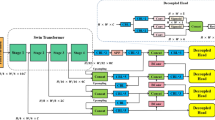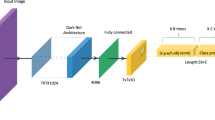Abstract
Segmentation networks based on deep learning are widely used in the field of industrial vision inspection, including for the precise segmentation of surface defects on printed circuit boards (PCBs). However, most previous studies have focused only on the utilization of defect samples with visible defects and underestimated the value of template samples without surface defects. In fact, template samples can provide sufficient prior information to identify defects and are not difficult to obtain in many manufacturing scenarios. Therefore, an adaptive feature reconstruction network (AFRNet) is proposed in this paper to utilize these two types of samples. Specifically, AFRNet consists of two main components: a Siamese encoder with shared parameters for extracting features from the input sample pair, and a symmetrical feature reconstruction module for adaptively fusing these extracted features. Similar image-level and feature-level fusion schemes, as well as spatial misalignment caused by unaligned sample pairs have been carefully studied. Extensive experiments on a real-world PCB surface-defect dataset confirm the effectiveness of the proposed method, demonstrating that it can significantly improve the segmentation performance of multiple baselines, such as DANet, PSPNet and DeepLabv3.








Similar content being viewed by others
Notes
The PCB surface-defect dataset is publicly available at https://github.com/youtang1993/MeiweiPCB.
References
Bromley, J., Guyon, I., LeCun, Y., et al. (1993). Signature verification using a siamese time delay neural network. In Advances in Neural Information Processing Systems 6, [7th NIPS Conference, Denver, Colorado, USA, 1993] (pp. 737–744). Morgan Kaufmann.
Çelik, A., Kucukmanisa, A., Sumer, A., et al. (2020). A real-time defective pixel detection system for LCDs using deep learning based object detectors. Journal of Intelligent Manufacturing, 1, 1–10. https://doi.org/10.1007/s10845-020-01704-9
Cen, M., & Jung, C. (2018). Fully convolutional siamese fusion networks for object tracking. In 2018 25th IEEE International Conference on Image Processing (ICIP) (pp. 3718–3722) https://doi.org/10.1109/ICIP.2018.8451102.
Chen, H., Pang, Y., Hu, Q., et al. (2020). Solar cell surface defect inspection based on multispectral convolutional neural network. Journal of Intelligent Manufacturing, 31, 453–468. https://doi.org/10.1007/s10845-018-1458-z
Chen, J., Yuan, Z., Peng, J., et al. (2021). DASNet: Dual attentive fully convolutional siamese networks for change detection in high-resolution satellite images. IEEE Journal of Selected Topics in Applied Earth Observations and Remote Sensing, 14, 1194–1206. https://doi.org/10.1109/JSTARS.2020.3037893
Chen, L., Papandreou, G., Kokkinos, I., et al. (2018). DeepLab: Semantic image segmentation with deep convolutional nets, atrous convolution, and fully connected CRFs. IEEE Transactions on Pattern Analysis and Machine Intelligence, 40(4), 834–848. https://doi.org/10.1109/TPAMI.2017.2699184
Chen, L., Zhu, Y., Papandreou, G., et al. (2018b). Encoder-decoder with atrous separable convolution for semantic image segmentation. In Computer Vision—ECCV 2018—15th European Conference, Munich, Germany, September 8–14, 2018, Proceedings, Part VII, Lecture Notes in Computer Science (Vol. 11211, pp. 833–851). Springer https://doi.org/10.1007/978-3-030-01234-2_49.
Chen, L. C., Papandreou, G., Schroff, F., et al. (2017). Rethinking atrous convolution for semantic image segmentation. CoRR abs/1706.05587. arXiv: 1706.05587.
Deng, J., Dong, W., Socher, R., et al. (2009). ImageNet: a large-scale hierarchical image database. In 2009 IEEE Computer Society Conference on Computer Vision and Pattern Recognition (CVPR 2009), 20–25 June 2009, Miami, Florida, USA. IEEE Computer Society (pp. 248–255). https://doi.org/10.1109/CVPR.2009.5206848.
Foumani, M., Ibrahim, M. Y., Gunawan, I. (2013). Scheduling dual gripper robotic cells with a hub machine. In 22nd IEEE International Symposium on Industrial Electronics, ISIE 2013, Taipei, Taiwan, May 28–31, 2013. IEEE (pp. 1–6). https://doi.org/10.1109/ISIE.2013.6563748.
Fu, J., Liu, J., Tian, H., et al. (2019). Dual attention network for scene segmentation. In 2019 IEEE/CVF Conference on Computer Vision and Pattern Recognition (CVPR). Computer Vision Foundation/IEEE (pp. 3141–3149) https://doi.org/10.1109/CVPR.2019.00326.
Gao, Y., Li, X., Wang, X. V., et al. (2021). A review on recent advances in vision-based defect recognition towards industrial intelligence. Journal of Manufacturing Systems, 1, 1–1. https://doi.org/10.1016/J.JMSY.2021.05.008
Hadsell, R., Chopra, S., LeCun, Y. (2006). Dimensionality reduction by learning an invariant mapping. In 2006 IEEE Computer Society Conference on Computer Vision and Pattern Recognition (CVPR 2006) 17–22 June 2006, New York, NY, USA (pp. 1735–1742). https://doi.org/10.1109/CVPR.2006.100.
He, K., Zhang, X., Ren, S., et al. (2014). Spatial pyramid pooling in deep convolutional networks for visual recognition. In Computer Vision—ECCV 2014—13th European Conference, Zurich, Switzerland, September 6–12, 2014, Proceedings, Part III, Lecture Notes in Computer Science (Vol. 8691, pp. 346–361). Springer. https://doi.org/10.1007/978-3-319-10578-9/23.
He, K., Zhang, X., Ren, S., et al. (2016). Deep residual learning for image recognition. In 2016 IEEE Conference on Computer Vision and Pattern Recognition, CVPR 2016, Las Vegas, NV, USA, June 27–30, 2016 (pp. 770–778). IEEE Computer Society. https://doi.org/10.1109/CVPR.2016.90.
He, T., Zhang, Z., Zhang, H., et al. (2019). Bag of tricks for image classification with convolutional neural networks. In IEEE Conference on Computer Vision and Pattern Recognition, CVPR 2019, Long Beach, CA, USA, June 16–20, 2019. Computer Vision Foundation/IEEE (pp. 558–567). https://doi.org/10.1109/CVPR.2019.00065.
Huang, Z., Wang, X., Wei, Y., et al. (2020). CCNet: Criss-cross attention for semantic segmentation. IEEE Transactions on Pattern Analysis and Machine Intelligence, 1, 603–612. https://doi.org/10.1109/TPAMI.2020.3007032
Kirillov, A., Wu, Y., He, K., et al. (2020). PointRend: Image segmentation as rendering. In 2020 IEEE/CVF Conference on Computer Vision and Pattern Recognition, CVPR 2020, Seattle, WA, USA, June 13–19, 2020 (pp. 9796–9805). IEEE. https://doi.org/10.1109/CVPR42600.2020.00982.
LeCun, Y., Boser, B. E., Denker, J. S., et al. (1989). Backpropagation applied to handwritten zip code recognition. Neural Computation, 1(4), 541–551. https://doi.org/10.1162/neco.1989.1.4.541
Lin, T., Goyal, P., Girshick, R. B., et al. (2020). Focal loss for dense object detection. IEEE Transactions on Pattern Analysis and Machine Intelligence, 42(2), 318–327. https://doi.org/10.1109/TPAMI.2018.2858826
Liu, R., Sun, Z., Wang, A., et al. (2020). Real-time defect detection network for polarizer based on deep learning. Journal of Intelligent Manufacturing, 31(8), 1813–1823. https://doi.org/10.1007/s10845-020-01536-7
Liu, S., Huang, D., Wang, Y. (2018). Receptive field block net for accurate and fast object detection. In Computer Vision—ECCV 2018—15th European Conference, Munich, Germany, September 8–14, 2018, Proceedings, Part XI, Lecture Notes in Computer Science. (Vol. 11215, pp. 404–419). Springer. https://doi.org/10.1007/978-3-030-01252-6/24.
Luo, Q., Fang, X., Liu, L., et al. (2020). Automated visual defect detection for flat steel surface: A survey. IEEE Transactions on Instrumentation and Measurement, 69(3), 626–644. https://doi.org/10.1109/TIM.2019.2963555
Miao, Y., Jeon, J., & Park, G. (2020). An image processing-based crack detection technique for pressed panel products. Journal of Manufacturing Systems, 57, 287–297. https://doi.org/10.1016/j.jmsy.2020.10.004
Schwendemann, S., Amjad, Z., & Sikora, A. (2021). A survey of machine-learning techniques for condition monitoring and predictive maintenance of bearings in grinding machines. Computers in Industry, 125(103), 380. https://doi.org/10.1016/j.compind.2020.103380
Shelhamer, E., Long, J., & Darrell, T. (2017). Fully convolutional networks for semantic segmentation. IEEE Transactions on Pattern Analysis and Machine Intelligence, 39(4), 640–651. https://doi.org/10.1109/TPAMI.2016.2572683
Shrivastava, A., Gupta, A., Girshick, R. B. (2016). Training region-based object detectors with online hard example mining. In 2016 IEEE Conference on Computer Vision and Pattern Recognition, CVPR 2016, Las Vegas, NV, USA, June 27–30, 2016 (pp. 761–769). IEEE Computer Society. https://doi.org/10.1109/CVPR.2016.89.
Smith, M. L., Smith, L. N., & Hansen, M. F. (2021). The quiet revolution in machine vision—A state-of-the-art survey paper, including historical review, perspectives, and future directions. Computers in Industry, 130(103), 472. https://doi.org/10.1016/j.compind.2021.103472
Song, K., & Yan, Y. (2013). A noise robust method based on completed local binary patterns for hot-rolled steel strip surface defects. Applied Surface Science, 285, 858–864. https://doi.org/10.1016/J.APSUSC.2013.09.002
Tabernik, D., Sela, S., Skvarc, J., et al. (2020). Segmentation-based deep-learning approach for surface-defect detection. Journal of Intelligent Manufacturing, 31(3), 759–776. https://doi.org/10.1007/s10845-019-01476-x
Tsai, D. M., & Rivera Molina, D. E. (2019). Morphology-based defect detection in machined surfaces with circular tool-mark patterns. Measurement, 134, 209–217. https://doi.org/10.1016/j.measurement.2018.10.079
Wang, X., Girshick, R. B., Gupta, A., et al. (2018). Non-local neural networks. In 2018 IEEE Conference on Computer Vision and Pattern Recognition, CVPR 2018, Salt Lake City, UT, USA, June 18–22, 2018 (pp. 7794–7803). IEEE Computer Society. https://doi.org/10.1109/CVPR.2018.00813.
Wang, Z., & Zhu, D. (2019). An accurate detection method for surface defects of complex components based on support vector machine and spreading algorithm. Measurement, 147(106), 886. https://doi.org/10.1016/J.MEASUREMENT.2019.106886
Wei, X., Yang, Z., Liu, Y., et al. (2019). Railway track fastener defect detection based on image processing and deep learning techniques: A comparative study. Engineering Applications of Artificial Intelligence, 80, 66–81. https://doi.org/10.1016/j.engappai.2019.01.008
Wu, N., Chu, F., Chu, C., et al. (2011). Petri net-based scheduling of single-arm cluster tools with reentrant atomic layer deposition processes. IEEE Transactions on Automation Science and Engineering, 8(1), 42–55. https://doi.org/10.1109/TASE.2010.2046736
Xiao, T., Liu, Y., Zhou, B., et al. (2018). Unified perceptual parsing for scene understanding. In Computer Vision—ECCV 2018—15th European Conference, Munich, Germany, September 8–14, 2018, Proceedings, Part V, Lecture Notes in Computer Science (Vol. 11209, pp. 432–448). Springer. https://doi.org/10.1007/978-3-030-01228-1/26.
Xing, J., & Jia, M. (2021). A convolutional neural network-based method for workpiece surface defect detection. Measurement, 176(109), 185. https://doi.org/10.1016/J.MEASUREMENT.2021.109185
Yang, Y., Yang, R., Pan, L., et al. (2020). A lightweight deep learning algorithm for inspection of laser welding defects on safety vent of power battery. Computers in Industry, 123(103), 306. https://doi.org/10.1016/j.compind.2020.103306
Yun, J., Shin, W., Koo, G., et al. (2020). Automated defect inspection system for metal surfaces based on deep learning and data augmentation. Journal of Manufacturing Systems, 55, 317–324. https://doi.org/10.1016/j.jmsy.2020.03.009
Zhang, H., Dana, K. J., Shi, J., et al. (2018). Context encoding for semantic segmentation. In 2018 IEEE Conference on Computer Vision and Pattern Recognition, CVPR 2018, Salt Lake City, UT, USA, June 18–22, 2018 (pp. 7151–7160). IEEE Computer Society. https://doi.org/10.1109/CVPR.2018.00747.
Zhang, H., Jiang, L., & Li, C. (2021). CS-ResNet: Cost-sensitive residual convolutional neural network for PCB cosmetic defect detection. Expert Systems with Applications, 185(1), 115–673. https://doi.org/10.1016/j.eswa.2021.115673
Zhao, H., Shi, J., Qi, X., et al. (2017). Pyramid scene parsing network. In 2017 IEEE Conference on Computer Vision and Pattern Recognition, CVPR 2017, Honolulu, HI, USA, July 21–26, 2017 (pp. 6230–6239). IEEE Computer Society. https://doi.org/10.1109/CVPR.2017.660.
Zhu, Z., Xu, M., Bai, S., et al. (2019). Asymmetric non-local neural networks for semantic segmentation. In 2019 IEEE/CVF International Conference on Computer Vision (ICCV) (pp. 593–602). IEEE https://doi.org/10.1109/ICCV.2019.00068.
Acknowledgements
This work was partially supported by the Key Areas Research and Development Program of Guangdong Province under Grant 2018B010109007 and the Key-Area Research and Development Program of Guangzhou under Grant 202007030004.
Author information
Authors and Affiliations
Corresponding author
Ethics declarations
Conflict of interest
There are no conflicts of interest to declare.
Ethical approval
We confirm that the content of the manuscript has not been published or submitted for publication elsewhere. All authors have seen the manuscript and approved it for submission to the journal.
Additional information
Publisher's Note
Springer Nature remains neutral with regard to jurisdictional claims in published maps and institutional affiliations.
Rights and permissions
Springer Nature or its licensor holds exclusive rights to this article under a publishing agreement with the author(s) or other rightsholder(s); author self-archiving of the accepted manuscript version of this article is solely governed by the terms of such publishing agreement and applicable law.
About this article
Cite this article
Kang, D., Lai, J., Zhu, J. et al. An adaptive feature reconstruction network for the precise segmentation of surface defects on printed circuit boards. J Intell Manuf 34, 3197–3214 (2023). https://doi.org/10.1007/s10845-022-02008-w
Received:
Accepted:
Published:
Issue Date:
DOI: https://doi.org/10.1007/s10845-022-02008-w




